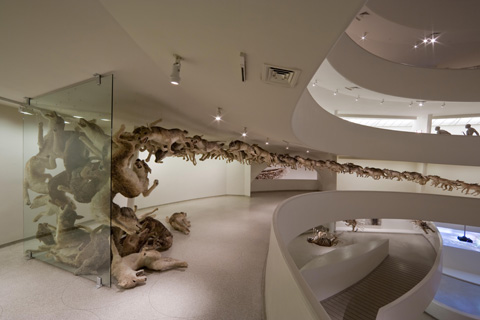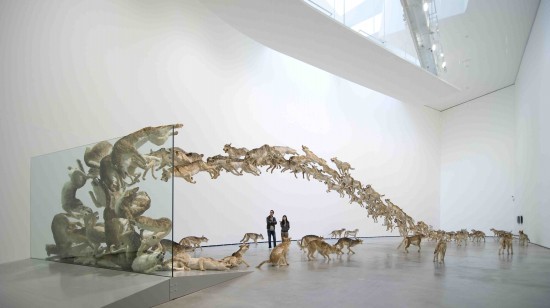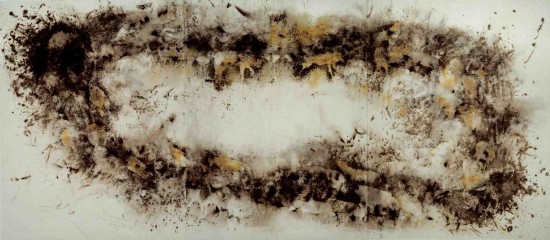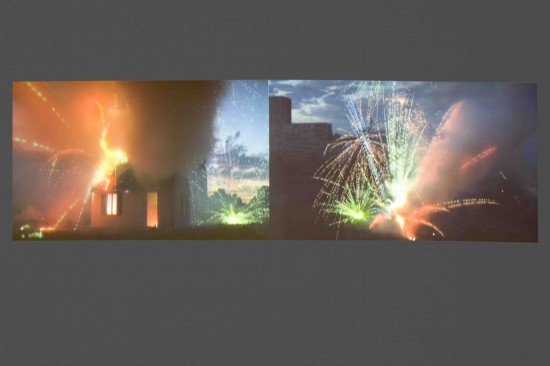


Head On (2006), 99 life-sized replicas of wolves and glass wall
I’ve always felt that the National Museum of Singapore is possibly one of the best places for site-specific art. Its history and significance as a prime cultural institution in Singapore provides fertile ground for relationships to be created between the work and its environment. Architecturally, the building is an elegant synthesis of the old and the new, offering ample material for artistic response. Most crucially, it possesses the one attribute most necessary for the generation of site-specific art, that of openness.
Compare it to The Esplanade, which despite its iconicity on the outside, is really quite a confusing clutter within. Granted, they do have a dedicated gallery for the visual arts, but beyond that, the art works inhabiting the rest of the building are inserted in the most awkward and inconsequential nooks and crannies, almost as if they are there just to fill up a structural gap or an empty wall.
This is why I was quite thrilled to hear that Cai Guo-Qiang’s Head On was making its way to the National Museum, which is co-presenting the work with Deutsche Bank. The piece is spectacular, with ninety-nine life-sized wolves leaping in an impressive arch towards an unseen wall. Those at the front of the pack smash head-on into the glass wall and collapse upon the ground, aghast and enfeebled. Given its physical majesty, I was secretly hoping that it would be installed in the concourse area of the museum, perhaps with the wolves leaping from it into the part of the basement aptly named “The Canyon”. Ah, but that was not to be.

Head On at the Solomon R. Guggenheim Museum
It was indeed a tad disappointing to find the piece enclosed in an empty, square, black gallery tucked away in the basement of the museum. Previously at the Solomon R. Guggenheim Museum, the work was exhibited along its iconic spiral walkway. Surely there could have been more meaningful methods of presentation here at our own museum, but I suspect that even if they had been conceived, they were possibly marred by logistical or bureaucratic difficulties.
Head On was first created for the Deutsche Guggenheim in Berlin, in response to the tensions which continued to exist between East and West Germany even after the fall of the Berlin Wall. Seen in this original context, the glass wall in Cai’s piece would unavoidably be seen as the invisible cultural wall or in other words, the physical wall’s intangible manifestation, which continues to fragment post-reunification Germany. But the work is certainly not one bound by a particular cultural or historical context. The glass wall is also a universal metaphor for an ideological dead-end, with the pack of wolves representing the human phalanx blindly in pursuit for abstract, lofty ideals in the name of revolutionary progress.
From a distance, the work is a sweeping, violent gesture. The wolves surge into the air fearless and undaunted, forming a magnificent arch which quite literally materialises the notion of an ideological movement. The seamless continuum of bodies emphasise their collectivity as a single, decisive stroke across the empty space of the gallery. But their collectivity is a source of strength as much as it is a fatal weakness, for it fosters a blind conformity towards the act of moving. Like their real-life human counterparts, the wolves are singularly fixated on the very act of creating and sustaining the movement, having already lost all awareness on what the movement actually means. They smash into the ideological dead-end, startled but unfazed. They pick themselves up and rejoin the movement in an endless loop. The movement which began as a revolution inspired by critical thought has become an act which is repeatedly performed by automation.

Head On at Guggenheim Museum Bilbao
The use of a blackened gallery, while seemingly uninspired, does actually produce some interesting effects irreproducible in its white wall equivalent and here is where I think credit must go to the curators. The violence and tragedy inherent in Cai’s piece relates proportionally to the work’s physical majesty, and without a space capable of magnifying its grandiosity, the work would have lost its punch.
In this case, the darkness of the room and the theatrical lighting endows the work an epic quality which elevates it to the status of an apotheosis of the human condition. There is a tinge of fatalism in the wolves’ depicted trajectory and the bleakness is farther accentuated by the cavernous void which surrounds it.
Interestingly, such sensations of terror and awe appear to diminish as we move nearer towards and within the work. In fact, the spatial interaction between the audience and the work is perhaps the best part of the experience. Our close proximity to the wolves reverses our earlier perceptions. The sense of violence has become entirely muted as we regard each animal with circumspection. They are really just replicas, or in other words, stuffed animals. Their expressions are frozen to the extent that they look quite foolishly dumbstruck. This notion is reinforced as we walk below the grand arch of these carnivorous bodies in flight. The wolves are not too high up to make one feel precarious. In fact, they dangle above you rather lamely, their limbs sticking out like silly appendages. Awe has given way to banality.
But the effect is likely deliberate. Actually, I think that there is an aspect of the work conceived to be quite tongue-in-cheek. The fact that the wolves are fabricated from painted sheepskins and stuffed with hay and metal wires corroborates this interpretation. This is a work about the tyranny of the collective as much as it is about its folly. There is terror but at the heart of it is a certain absurdity which underlies all forms of quixotic ideological pursuits.

Vortex (2006), Gunpowder on paper
Two other works by Cai accompany the centrepiece of the exhibition. A similar sense of muted violence is perceptible in Vortex, a mural-sized drawing made with gunpowder. The drawing depicts hundreds of wolves chasing one another in a circle – very much the similar motifs used in Head On. Their forms are hardly even discernible, existing more like a continuous sweep of energy, largely owing to the caprice and imprecision of the gunpowder medium. Like many of Cai’s gunpowder works, the huge drawing inspires awe as much as it also contains a characteristic silence; for what we witness is not the act of violence but its remnants. The imprints of the wolves are like ghosts inhabiting a post-apocalyptic world. In fact, the darkened, cave-like environment of the gallery significantly reinforces such impressions. The drawing takes on the guise of a prehistoric cave painting, lending it a primordial and almost mythic quality.
An accompanying video next to the work documents the making of the work at a press conference prior to his exhibition opening at the Deutsche Bank Atrium. We watch Cai as he sprinkles and spreads the gunpowder around the stencils of the wolves which have been laid on the paper. He then lights the fuse and sets off the explosion, leaving behind burned, smoked, charcoal-colored marks on the paper.

Illusion II (2006), Two-channel video installation
Meanwhile, violence is explicit in Illusion II. The two-channel video installation is an accompanying piece to Cai’s explosion project of the same name. The video features a German-style house constructed by the artist which is eventually destroyed by the waves of fireworks erupting from inside the house. Despite its destructive capacity, the brilliant fireworks tantalise the senses in a piece where poetry and violence coexist uneasily.
While the three works on display can hardly be an adequate representation of the artist’s entire oeuvre, their spectacular nature offers a vivid illustration of Cai’s approach towards art-making. Here we have an artist whose signature is strikingly contemporary but whose impulse deviate little from the artistic tradition of examining terror and beauty.
Head On is currently running at the National Museum of Singapore from 2 July to 31 August 2010. Admission is free.
~
Ho Rui An is an independent filmmaker, artist and writer from Singapore. He publishes his writings on the arts, culture and society on his weblog, http://opencontours.wordpress.com
Sorry, the comment form is closed at this time.
The wolves are actually capable of leaping over the glass wall but made their jump too early. They know the problem and they can solve problem but they don’t.
They could also run around the glass wall but do not. The problem is not a really a problem at all, but they don’t know that.
This means Kentucky Fried Chicken and Pepsi will never be as successful as McDonalds and Coca-Cola.